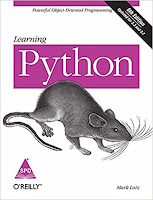 |
| Learning Python by Mark Lutz |
For next few months, I would be posting my experiences with Python more specifically the learning I am going through from the book - "Learning Python by Mark Lutz". You can find all of my reading journal of this book and accompanying code in GitHub
The rest of this post covers what I learned in Chapter 2 and Chapter 3.
Chapter 2: How Python Runs Programs
This chapter introduces you a needed theoretical overview of Python runtime (interpreter) and Python bytecode. The execution of the program is explained in two viewpoints - programmer's view and Python's view. The programmers' view is what code to be written following the language constructs generating source code and Python's view is how to execute the program converting source code to actual functionality (the output of programmer view is input to Python's view). The chapter offers execution model variations (different runtime models - CPython, Jython, Stackless, PyPy) and optimization tools (Psyco JIT, Shed Skin, Cthyon). This chapter is wonderfully written and there will be some learning to everyone. I thoroughly enjoyed the content :-). Kudos to the author for covering a variety of insights.
Chapter 3: How You Run Programs
I need to start with a warning. This chapter has so much information and ways to run your code like "from the command line", "interactive", "IDLE" and "IDE". I personally suggest that we should try all the methods at least once and choose one of the methods. I find IDE convenient. Yes, I do use PyCharm community edition. On the good side, the chapter introduces modules, importing, namespaces, module reloads which is quite interesting. Good round up of exercises at the end. I do not want to bog you down with a lot of details. One little advice I have for you is to take breaks while reading this chapter and be prepared for a long haul. Without the break, I feel this chapter is little tough to complete and might appear daunting (and might be demotivating to complete). The good thing about such details are completeness
BTW, with this, we complete the first part of the book and we have eight more parts.
Looking forward to the Part 2
All posts related to "Learning Python by Mark Lutz"
Source Code@GitHub (exercises of this book)
Friendly Note: I am posting the images and links from the publisher's website. I am not an affiliate and I do not get paid for writing this. If my journal is useful for someone to learn Python, I am more than happy :-)
Chapter 2: How Python Runs Programs
This chapter introduces you a needed theoretical overview of Python runtime (interpreter) and Python bytecode. The execution of the program is explained in two viewpoints - programmer's view and Python's view. The programmers' view is what code to be written following the language constructs generating source code and Python's view is how to execute the program converting source code to actual functionality (the output of programmer view is input to Python's view). The chapter offers execution model variations (different runtime models - CPython, Jython, Stackless, PyPy) and optimization tools (Psyco JIT, Shed Skin, Cthyon). This chapter is wonderfully written and there will be some learning to everyone. I thoroughly enjoyed the content :-). Kudos to the author for covering a variety of insights.
Chapter 3: How You Run Programs
I need to start with a warning. This chapter has so much information and ways to run your code like "from the command line", "interactive", "IDLE" and "IDE". I personally suggest that we should try all the methods at least once and choose one of the methods. I find IDE convenient. Yes, I do use PyCharm community edition. On the good side, the chapter introduces modules, importing, namespaces, module reloads which is quite interesting. Good round up of exercises at the end. I do not want to bog you down with a lot of details. One little advice I have for you is to take breaks while reading this chapter and be prepared for a long haul. Without the break, I feel this chapter is little tough to complete and might appear daunting (and might be demotivating to complete). The good thing about such details are completeness
BTW, with this, we complete the first part of the book and we have eight more parts.
Looking forward to the Part 2
All posts related to "Learning Python by Mark Lutz"
Source Code@GitHub (exercises of this book)
Friendly Note: I am posting the images and links from the publisher's website. I am not an affiliate and I do not get paid for writing this. If my journal is useful for someone to learn Python, I am more than happy :-)




